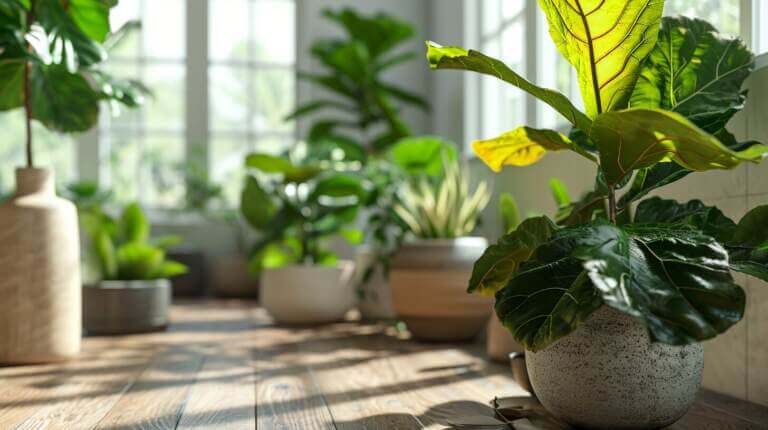Are you ready to embark on a green journey and cultivate the flourishing beauty of an arrowhead plant? Look no further! This article is your guide to success, providing you with essential tips for healthy growth.
Discover the perfect location, ensure ample lighting, and meet the watering and humidity needs of your plant.
With expert advice on fertilizing, propagation, and pruning techniques, you’ll be well on your way to creating a thriving oasis that you and your arrowhead plant can call home.
Key Takeaways
- Choose a location with optimal temperature and lighting conditions, such as bright, indirect sunlight indoors or a partly shaded area outdoors.
- Ensure good drainage in the pot or planting area and consider higher humidity levels to promote healthy growth.
- Use room temperature water to water the plant when the top inch of soil feels dry, and mist the leaves regularly to increase humidity.
- Regularly fertilize the arrowhead plant with the necessary nutrients, either through organic or synthetic fertilizers, to support its growth and avoid nutrient imbalances.
Choosing the Right Location
Choose a location that provides the optimal conditions for your arrowhead plant’s growth. Whether you decide to keep it indoors or outdoors, the ideal temperature for your arrowhead plant is between 60 to 75 degrees Fahrenheit.
Indoors, find a spot that receives bright, indirect sunlight. Avoid placing it in direct sunlight as it can scorch the leaves. If you choose to grow it outdoors, ensure it’s in a partly shaded area, protected from intense sunlight.
The arrowhead plant thrives in well-draining soil, so make sure the pot or planting area has good drainage. Additionally, consider the humidity levels in the chosen location. Arrowhead plants prefer higher humidity, so misting the leaves or placing a tray of water nearby can help create the ideal environment.
Providing Adequate Lighting
To ensure healthy growth for your arrowhead plant, it’s important to provide it with proper lighting conditions. Proper light exposure is crucial for the plant to thrive and maintain its vibrant foliage.
While arrowhead plants can tolerate low light conditions, they prefer bright, indirect light. If you don’t have access to natural sunlight, you can consider using artificial lighting options to meet the plant’s light requirements. LED grow lights and fluorescent lights are excellent choices as they provide the right spectrum of light for photosynthesis.
When using artificial lighting, it’s essential to position the lights about 12 to 18 inches above the plant to mimic natural sunlight. Remember to adjust the lighting duration based on the needs of your arrowhead plant.
Watering and Humidity Needs
After providing adequate lighting for your arrowhead plant, it’s important to address its watering and humidity needs to ensure its continued health and growth. Proper watering techniques are essential for maintaining the right moisture levels in the soil. Here are some tips to help you keep your arrowhead plant happy:
- Water your plant when the top inch of soil feels dry to the touch.
- Use room temperature water to avoid shocking the roots.
- Allow excess water to drain out of the pot to prevent waterlogged soil.
- Mist the leaves regularly to increase humidity, as arrowhead plants thrive in humid conditions.
In addition to watering, maintaining proper humidity levels is crucial. Adequate humidity helps prevent pests like spider mites and aphids from infesting your plant. Placing a humidifier nearby or grouping your arrowhead plant with other plants can create a more humid environment, promoting healthy growth and preventing pests.
Fertilizing for Healthy Growth
To maintain healthy growth in your arrowhead plant, it’s important to provide the necessary nutrients through regular fertilizing.
Arrowhead plants have specific nutrient requirements that need to be met in order for them to thrive. Nitrogen, phosphorus, and potassium are essential for their growth and overall health.
When it comes to choosing fertilizers, you have the option of using organic or synthetic fertilizers. Organic fertilizers, such as compost or worm castings, are derived from natural sources and provide a slow release of nutrients. They also improve soil structure and promote beneficial microorganisms.
On the other hand, synthetic fertilizers are manufactured and provide a quick release of nutrients. They can be more concentrated and targeted, but they may also lead to nutrient imbalances if not used correctly.
Consider the specific needs of your arrowhead plant and choose a fertilizer that best meets those requirements.
Propagation and Pruning Techniques
Maintain the healthy growth of your arrowhead plant by learning proper propagation and pruning techniques.
Propagation methods for arrowhead plants include division and stem cuttings. Division involves separating the plant into smaller sections, each with its own roots, and replanting them. Stem cuttings can be taken from healthy stems and placed in water or soil to encourage root growth. This allows you to propagate multiple plants from a single parent plant.
When it comes to pruning, arrowhead plants benefit from regular trimming to maintain their shape and promote new growth. Pruning frequency can vary depending on the desired size and shape of the plant, but it’s generally recommended to prune every few months. Regular pruning also helps to prevent the plant from becoming leggy and promotes bushier growth.
Frequently Asked Questions
How Often Should I Repot My Arrowhead Plant?
To keep your arrowhead plant healthy, it’s important to know when to repot it. Repotting frequency depends on the size and growth rate of your plant.
Generally, you should repot your arrowhead plant every 1-2 years. Signs that it’s time to repot include roots growing out of the drainage holes, the plant becoming root-bound, or the soil not retaining moisture properly.
Repotting will provide your arrowhead plant with fresh soil and room to grow.
Can I Grow an Arrowhead Plant in a Hanging Basket?
Sure, you can definitely grow an arrowhead plant in a hanging basket!
Picture this: you walk into your living room and are instantly greeted by a stunning display of lush green leaves cascading down from a beautiful hanging basket.
That’s the beauty of growing an arrowhead plant in a hanging basket. It not only adds a touch of nature to your space but also allows you to make the most of limited floor space.
Plus, arrowhead plants are known to be one of the best hanging plants, thanks to their trailing growth habit and low maintenance arrowhead plant care requirements.
What Are the Common Pests and Diseases That Affect Arrowhead Plants?
Common pests and diseases can be a real headache when it comes to arrowhead plants. But don’t worry, there are ways to prevent and treat them.
Some common pests to watch out for include spider mites, aphids, and mealybugs. To keep them at bay, regularly inspect your plant and use insecticidal soap if needed.
As for diseases, root rot and leaf spots are the usual suspects. Make sure to provide proper drainage and avoid overwatering to prevent these problems.
Can Arrowhead Plants Be Grown Outdoors in Colder Climates?
Yes, arrowhead plants can be grown outdoors in colder climates, but they’re more commonly grown indoors. When growing arrowhead plants indoors, make sure to choose the best soil for them. They thrive in well-draining soil that’s rich in organic matter. This will provide the necessary nutrients for healthy growth.
Additionally, keep in mind that arrowhead plants prefer indirect light and moderate humidity levels. Following these tips will help you cultivate a thriving arrowhead plant indoors.
How Long Does It Take for an Arrowhead Plant to Grow New Leaves?
When growing an arrowhead plant, it’s important to know how long it takes for new leaves to appear. Arrowhead plants typically grow new leaves every few weeks under optimal conditions.
To ensure healthy growth, provide proper arrowhead plant care and propagation techniques. This includes providing adequate sunlight, watering regularly, and using well-draining soil.







